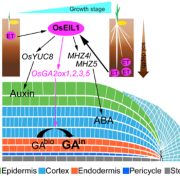HY5a regulates winter dormancy in poplar
Gao, Chen et al. explore the regulatory mechanisms governing winter dormancy in trees.
https://doi.org/10.1093/plcell/koae022
Yongfeng Gao, Zihao Chen and Yinan Yao
School of Life Science and Engineering, Southwest University of Science and Technology, 621010 Mianyang, China
Background: Winter dormancy, a process where growth stops and plants acquire a dormant and freezing-tolerant state, is crucial for the survival of woody plants in boreal and temperate regions. The seasonal growth of perennial woody plants is controlled by dormancy entry and release, which are regulated by complex and precise mechanisms influenced by environmental cues. Dormancy entry is mainly induced by short photoperiods and is characterized by growth cessation and bud set. The central activator of flowering, FLOWERING LOCUS T (FT), is also the key target for winter dormancy induction. To satisfy distinct needs in dormancy or flowering, woody plants likely use different pathways than herbaceous plants use to regulate FT. Although a LATE ELONGATED HYPOCOTYL (LHY)–FT regulatory pathway analogous to that in herbaceous plants exists in woody plants, its efficacy in preventing dormancy in trees is limited.
Question: Do other regulatory mechanisms regulate winter dormancy in trees?
Findings: We determined that PtoHY5a, a poplar (Populus tomentosa) ortholog of Arabidopsis (Arabidopsis thaliana) ELONGATED HYPOCOTYL5 (HY5), mediates dormancy induction downstream of photoreceptor PHYB signaling. PtoHY5a directly and indirectly regulates the key target for winter dormancy induction, FT2, via two transcriptional modules. Moreover, PtoHY5a controls gibberellic acid levels in apical buds to inhibit bud break in poplar.
Next steps: The next step would be to explore PtoHY5a as a key target for genetic modification in trees. Genetic modification of PtoHY5a could be particularly useful when introducing trees to different latitudes; for instance, from northern regions to high-altitude southern areas, such as from the Tibetan Plateau to the South Asian Highlands, or vice versa. By understanding and manipulating PtoHY5a, we could potentially optimize tree adaptation to new environments, thereby enhancing their survival and productivity.
Reference:
Yongfeng Gao, Zihao Chen, Qian Feng, Tao Long, Jihua Ding, Peng Shu, Heng Deng, Peizhi Yu, Wenrong Tan, Siqin Liu, Lucas Gutierrez Rodriguez, Lijun Wang, Víctor Resco de Dios, Yinan Yao. (2024). ELONGATED HYPOCOTYL 5a modulates FLOWERING LOCUS T2 and gibberellin levels to control dormancy and bud-break in poplar. https://doi.org/10.1093/plcell/koae022







